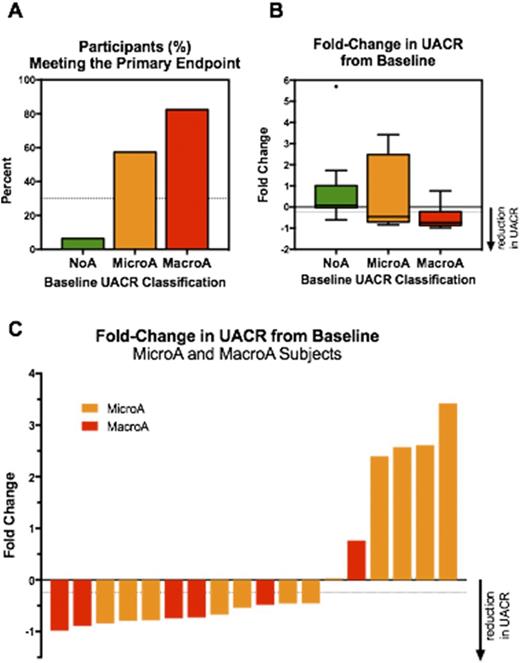Abstract

Background: Sickle nephropathy (SN) is a common and progressive manifestation of sickle cell anemia (SCA). Albuminuria indicates glomerular injury and portends renal failure. In a murine model of SCA, we found that increased TGF-Beta signaling underlies SN, and its downregulation by losartan, an angiotensin receptor blocker, reduced albuminuria and SN progression. The effect of losartan in humans with SCA has not been studied. We performed a phase-2, open-label study to inform the design of a phase-3 randomized trial to estimate the effect of losartan on SN. We also explored the effect of losartan on the cardiac phenotype of SCA.
Methods: Oral losartan was administered for 6 months to individuals with SCA (HbSS or SBeta0-thalassemia) >6 years of age. Main exclusion criteria: chronic transfusions, GFR <60 mL/min/1.73m2, hyperkalemia, and contraindications to losartan. Enrollment was in 3 groups defined by urinary albumin-to-creatinine ratio (UACR): no albuminuria (NoA: <30mg/g); microalbuminuria (MicroA: 30-300); and macroalbuminuria (MacroA: >300). The primary endpoint was a >25% reduction UACR from baseline. Sample size was calculated to detect the primary endpoint in >30% of the MicroA group with >80% power. Secondary endpoints: urine osmolality, GFR, UACR classification and toxicity, and cardiac phenotyping by echocardiography and assessment of 6-minute walk distance (6MWD).
Results: There were 36 participants (mean age 24.1y; 53% female) in 3 groups (NoA=15; MicroA=13; MacroA=8). Four were not evaluable based on pre-specified criteria (marked non-compliance and/or early termination). The primary endpoint (>25% reduction in UACR) was met in 83% (5/6) of the MacroA group, 58% (7/12) of the MicroA group, and 7% (1/14) of the NoA group (FigureA). The median fold-change in UACR was -0.74, -0.46, and 0.08 for the MacroA, MicroA, and NoA groups, respectively (FigureB). Among MacroA and MicroA participants, 67% (12/18) met the primary endpoint (FigureC). In MacroA and MicroA participants, UACR classification improved (MacroAˆMicroA or MicroAˆNoA) in 50% but worsened in 11%. Mean UACR was 202 mg/g (S.E.M. 59, median 50) before and 137 (S.E.M. 47, median 16) after losartan (P=0.29). Urine osmolality and GFR did not change significantly (393 vs 370 mosm/kg H20, P=0.11; 147 vs 139 mL/min/1.73m2, P=0.43). Losartan was discontinued for leg cramps (N=1); GFR decline >25% (N=1); and serum creatinine rise >50% (N=1). Interestingly, compared to those with NoA, participants with albuminuria (MicroA and MacroA, mean UACR 373±87 mg/g) had worse diastolic function indicated by lower early-to-late ratio of mitral inflow velocities, E/A (1.81±0.1 vs 2.3±0.1, P=0.018), and septal annular velocities ratio, e'/a' (1.5±0.2 vs 2.4±0.2, P<0.001), and significantly larger left atrial volumes (57.2±3.1 vs 38.9±3.7 ml, P<0.001). Systolic function was normal and similar in both groups (shortening fraction 36.9±2% vs 36.7±1.5%, P=0.94). There was no difference in tricuspid regurgitant jet velocity, left ventricular (LV) mass, or LV diameter. Participants with albuminuria had significantly shorter 6MWD (1182±78 vs 1472±86 ft, P=0.018), which correlated significantly with the diastolic measures E/A and septal e'/a' (P=0.013 and P=0.015, respectively). There was no change in echocardiographic parameters after losartan therapy.
Conclusions: Losartan appeared to decrease SCA-related albuminuria in most participants. Those with baseline macroalbuminuria appeared to have the greatest benefit, nearly all of whom showed a response. Albuminuria, a marker of sickle nephropathy, is also associated with evidence of restrictive cardiac physiology, suggesting common underlying mechanisms. However, the short 6-month treatment with losartan had no obvious effects on the cardiac phenotype of SCA. A phase-3, randomized, placebo-controlled trial is being designed to determine the efficacy of losartan in SCA. [This work was supported by NIH R34 HL 108752 (PI: Malik, P)].
Quinn:Silver Lake Research Corporation: Consultancy; Eli Lilly: Research Funding; Amgen: Research Funding. Raj:Novartis: Speakers Bureau.
Author notes
Asterisk with author names denotes non-ASH members.

This icon denotes a clinically relevant abstract


This feature is available to Subscribers Only
Sign In or Create an Account Close Modal